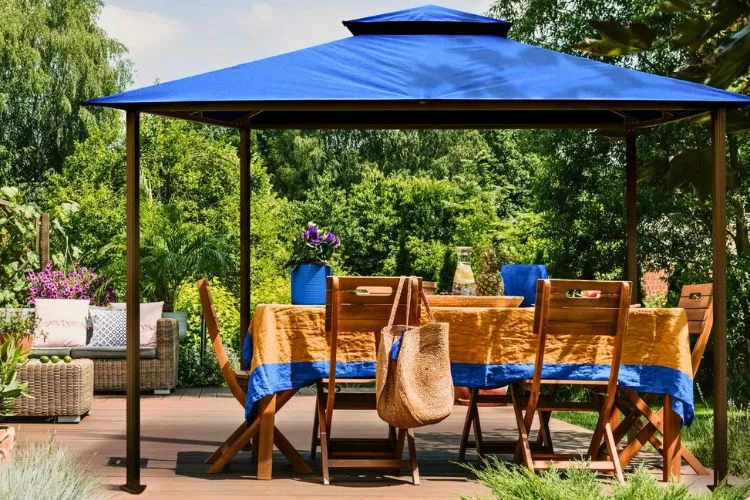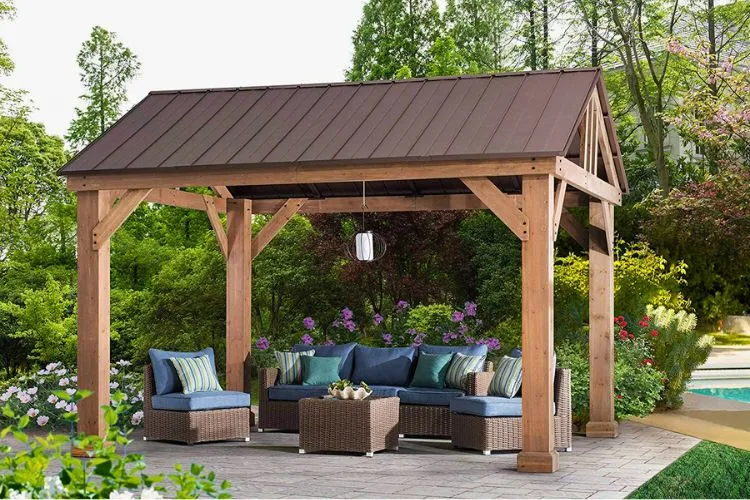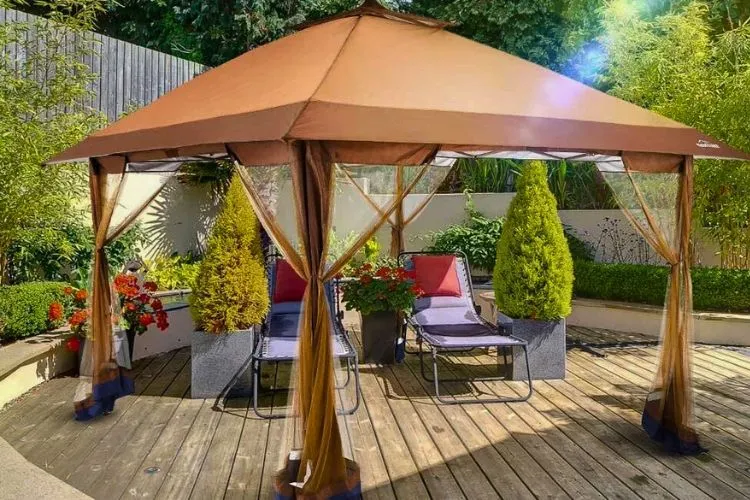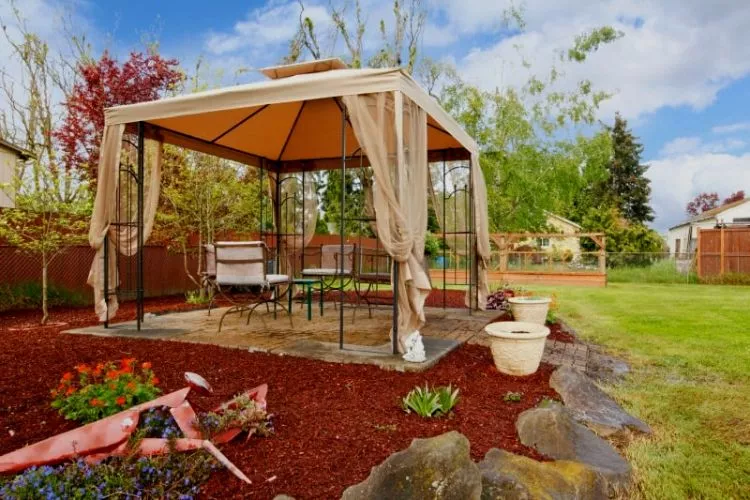Transforming your outdoor living space can be as simple as updating the color of your gazebo cover.
However, can you dye gazebo cover?
Honestly speaking, dyeing your gazebo is an incredible way to add a custom touch to your backyard.

Read on for an in-depth guide that’ll ensure your next project is a bright success.
Contents
Can You Dye Gazebo Cover?
Yes, you can dye a gazebo cover. The process typically consists of preparing a dye bath according to the manufacturer’s instructions, then immersing the cover in the dye.
Careful time and temperature control are essential for achieving even coloration. After dyeing, thoroughly rinse and wash the cover to remove excess dye and let it dry, avoiding direct sunlight to prevent color fading.
The procedure requires careful attention to ensure even coverage and prevent dye from bleeding onto other surfaces. Please note that results can vary based on the fabric and dye used.
Understanding Gazebo Cover Materials
Before you begin, it’s important to recognize the material of your gazebo cover, as the dyeing process differs accordingly.

Polyester Covers
Polyester covers are known for their resilience but dyeing them can be challenging due to their synthetic nature. They often have a water-repellent finish that impedes the dye’s absorption.
Even so, with a dye that’s formulated for synthetic fabrics, you can achieve a stunning result.
Vinyl Covers
Vinyl covers are non-absorbent, which makes the dyeing process more complicated. Dyes must be specially designed to bond with vinyl, otherwise, they will simply wash away, leaving a pale and uneven color.
Canvas Covers
Canvas is often made from natural fibers like cotton, which soaks up dye more readily than synthetic materials. It offers pleasing results and is a preferred material for dyeing projects.
Pre-Dyeing Procedures
The success of your dyeing project largely depends on the preparations you make.

Cleaning the Cover
An immaculate surface is key to a uniform dye job. Clean the gazebo cover with a fabric-appropriate cleaner to remove dirt, oil, or any existing treatments that might prevent the dye from setting properly.
Drying Techniques
After a thorough wash, the cover must be completely dried. Any moisture remaining can cause the dye to spread unevenly, resulting in a blotchy appearance. Naturally air-drying is recommended to ensure no moisture remains.
The Dye Selection Process
Selecting the correct dye will determine the longevity and vibrancy of your cover.
Fabric Dyes
There are specific dyes available for different fabric types—each with instructions tailored to the material it’s best suited for. Choose a dye that is made for polyester, vinyl, or canvas, depending on your gazebo cover.
Spray Dyes
Spray dyes work well for materials that are difficult to immerse in liquid dye. They can be particularly useful for vinyl covers where standard fabric dyes won’t adhere. When using spray dyes, it’s essential to apply them evenly to prevent patchiness.
Step-by-Step Gazebo Cover Dyeing
Before diving into the specifics, it’s crucial to remind you that each dye manufacturer will have its specific set of instructions. Always adhere to these for optimal results.

Immersing in Dye Bath
Usually, the dyeing process involves submerging the gazebo cover entirely in the dye bath. Ensure the fabric is fully saturated and there are no folds or air bubbles trapped that might result in uneven dyeing.
Time & Temperature Control
The consistency of color on the fabric can largely be controlled by the duration it remains in the dye bath and the temperature at which the dyeing is performed.
Generally, a longer immersion time and higher temperature will result in darker, richer colors. Always defer to the manufacturer’s guidelines for specific time and temperature controls.
Achieving Even Coverage
Ensuring an even coverage is paramount to have a pleasing final look. Here are some tips to help with that:
- Stirring the Fabric: While the gazebo cover is in the dye bath, make sure to keep it moving. Stirring the fabric occasionally can help the dye penetrate evenly.
- Multiple Applications: If after one application the color is not rich enough, consider multiple applications. But remember, each application should be followed by a thorough rinse to remove any excess dye before proceeding to the next one.
Post-Dyeing Care
Following the dyeing process, your work still isn’t complete. Post-dye care is crucial to maintain the integrity of the color and prevent damage to other surfaces.

Rinse & Wash
Once the desired shade is achieved, remove the fabric from the dye bath and rinse it thoroughly under cold running water until the water runs clear.
This process removes excess dye that might still be on the fabric surface. You can then wash the cover gently with a mild detergent to ensure all residual dye is removed.
Drying
After the rinse and wash, it’s time to dry the cover. If possible, it’s best to dry the gazebo cover naturally, laid flat to maintain its shape. Avoid direct sunlight, which might cause the color to fade. As the fabric dries, the color will also set in place.
Remember, dyeing is equally science and art, which requires patience, precision, and a knack for color. Happy dyeing!
Safety and Environmental Considerations
Safety should never be compromised. Always wear gloves and protective clothing to avoid skin irritation. Furthermore, opt for environmentally-friendly dyes to minimize any negative impact on the ecosystem.
With this comprehensive guide, you’re well on your way to giving your gazebo cover a vibrant new life. Dive into this simple project and witness the transformation of your outdoor space.
Conclusion:
In conclusion, dyeing your gazebo cover is not only feasible but it can also be an enjoyable and rewarding DIY project. With careful consideration of the fabric type—be it polyester, vinyl, or canvas—you can select the appropriate dye and pre-dyeing treatments to ensure a successful outcome.
Though each material presents its own set of challenges, from the need for special dyes for synthetic fabrics to ensuring even application on less absorbent materials like vinyl, the process is approachable with the right preparation and patience.
By following the step-by-step guide to clean, dry, and dye your gazebo cover, and by adhering to safety and environmental guidelines, you can rejuvenate and customize your outdoor living space in a vibrant and lasting way.
Whether you’re aiming for a bold transformation or a subtle refresh, dyeing your gazebo cover offers a personalized touch that reflects your style and enhances your outdoor ambiance. So, gear up, choose your color, and embrace the opportunity to make your gazebo stand out. Your backyard oasis awaits.

Sergio Gomes, a passionate advocate for outdoor living and the male voice behind Shades Authority. With years of experience, Sergio is your trusted source for expert insights on gazebos, pavilions, cabanas, pergolas, and all things outdoor shade solutions. Join him on a journey to transform your outdoor spaces into stunning, functional retreats
